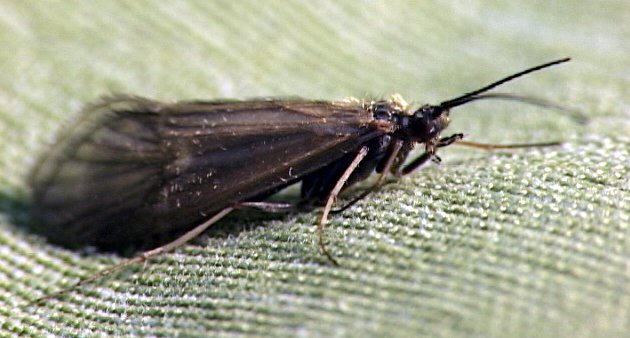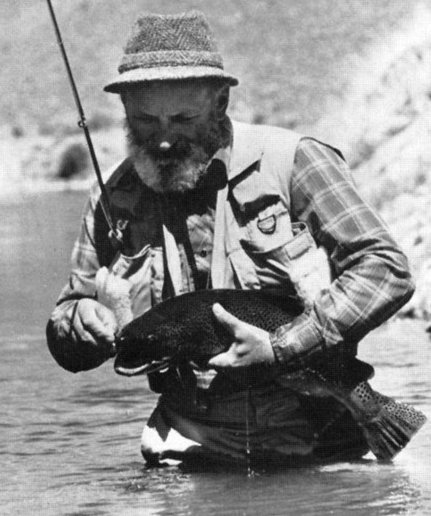Black Elk Hair Caddis (Sedge) Fly
To understand the design of the Black Elk Hair Caddis fly you need to know a little of the natural history of the caddis. When the caddis hatch the emergent adult tries to swim as fast as it can to the safety of the bank.

CADDIS FLY PATTERNS. Hook size 10 12 14 16 18 20 - $US each
In this mad dash for survival the newly hatched caddis creates a 'V' shaped wake a bit like a small speed boat. The trout are on the look out for this give away sign of fast food on the move and home in on these flies with some spectacular takes. This pattern was designed by Al Troth in Pennsylvania, USA in the 1950's, to imitate the adult caddis in two ways: firstly by copying the shape of the wings and secondly he made sure the blunt stubby wings caused a disturbance on the retrieve, in the water surface that mimics that caused by the scuttering adults. Al Troth used a typical roof wing profile to mimic a whole range of medium to small caddis flies rather than try to imitate a particular species. Al Troth later moved to Montana where he gained fame as a fly tier and trout guide. His new Elk Hair Caddis Dry flies soon became widely used in the various trout rivers of the Rocky Mountains. It is now used all over the world. Elk Hair Caddis flies are not the answer to all your rising fish fly fishing situations. When the trout are sipping little blue winged olives from the water surface they will often ignore a large floating Elk Hair. But during quiet periods without any major hatch underway the Elk Hair Caddis is a great searching fly for drawing strikes from larger than average trout. The versatility of this fly is the key to its success. Fished dead-drifted over a rising trout will often draw a strike, but when this does not work the high floating characteristics means it can be skated, twitched or otherwise worked on the surface to get a response. Sometimes these tactics can draw slashing strikes from large fish as big trout hammer the fly with the same gusto of a big bass taking a surface deerhair popper.
I like to fish these flies down and across the stream. I use a reach-casting and then slack line technique to avid drag. When the line tightens in the current I twitch the fly briefly and then lower the rod tip to create slack and the momentary dead drift of the fly as if it is resting. I dress both fly and leader with floatant. The leader must be floating along with the fly or your twitches will drag the fly under. Sometimes I only dress the fly with floatant. The leader tippet sinks drawing the fly under when it is twitched. If you give it some slack at this point the Elk hair will bob quickly back up to the surface in an action trout find irresistible. The Elk Hair Caddis's extreme buoyancy means that it also works well as a strike indicator

The common or slang term ‘sedge’ originates from the fact that adult Caddis flies can often be found clinging to sedge grass near the waters. Sedge/Caddis flies have four wings. The forward pair are normally a little longer than those at the rear. At rest their wings lie close along the body in an inverted V shape. Caddis flies do not have tails but many have long antenna. The Latin name for this group of flies is ‘Trichoptera’. They pass through four stages in their development; egg, larva, pupa and adult. The eggs are laid by the adult female in large jelly mass, which often floats on the water surface and drift until they stick to some river side vegetation. Some species lay their eggs directly on vegetation.
The eggs hatch into larva in about 10-12 days. The Larvae produce a sticky substance and attach what ever material in on the river bed to their body. This offers protection and camouflage. The pupa stage lasts for several days. The fully formed pupa has middle body legs that it uses to swim to the surface to hatch. Some species choose the shore or vegetation to emerge rather than open water where they are easy prey for the trout. Adult caddis flies vary in size. Their bodies are rather drab in color from gray, brown to green. The wings are mottled, patterned or pale and vary in color from black, brown to gray. If the fish are not taking fly patterns of natural colors try a brightly colored attractor pattern of the correct shape. Most hatch early or late evening. Some hatch in the afternoon and some at night. The fish have two chances of catching these flies; when they emerge and when they return to lay eggs. Some species have a problem drying their wings and remain on the surface for a considerable time, causing a disturbance. Others that move to shore to hatch fully also cause a disturbance.

Fly Fisherman Al Troth designed the popular Elk Hair Caddis dry fly


